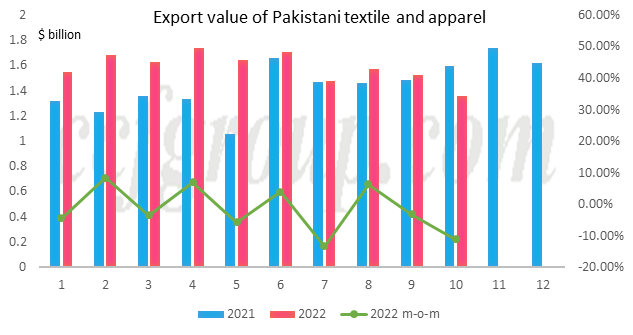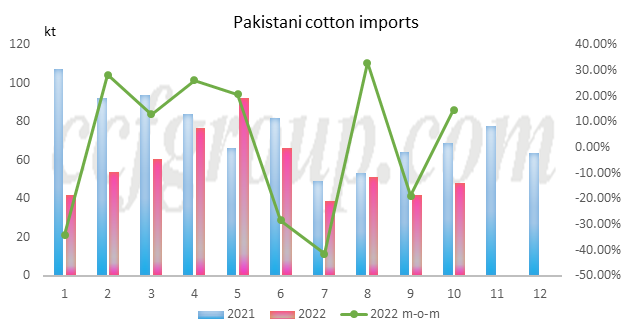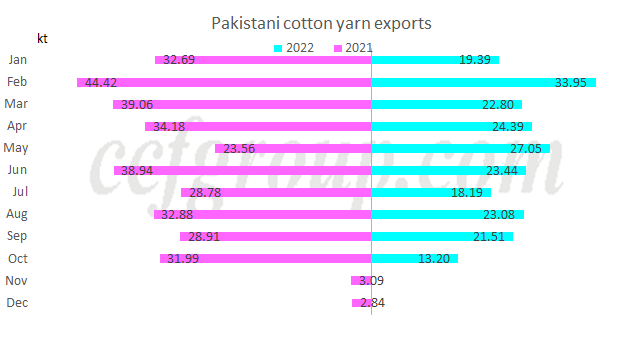Pakistani cotton yarn exports hit new low in recent ten years
1. Pakistani textile and apparel exports continue to move down in Oct, 2022


Pakistani textile and apparel exports slipped greatly recent months instead of sharp increase in the first half of this year. In Oct 2022, Pakistani textile and apparel export value hit new low and reached $1357 million, down $170 million compared to last month. The lack of orders in South Asia gradually showed. The exports value of knitted fabrics and beddings reduced mostly dramatically, and both declined almost $100 million on month. Meanwhile, not only textile and apparel exports in end market shrank, but the export demand for commodities like yarn and fabric also weakened. In comparison, Pakistani import value rose to about $320 million, up 9% on month in Oct.
2. Pakistani raw cotton imports reached 47.8kt in Oct 2022

More demand for imported cotton was still the main reason for the increase of Pakistani textile and apparel. Pakistani cotton imports rose to 47.8kt in Oct 2022, up 14.7% on month. Since this year, the data of Pakistani contract with US, Australian and Brazilian cotton was great. The reduction of cotton production caused by disaster made Pakistani cotton prices not as expected, which also caused high-priced Pakistani cotton yarn price. The operating rate of Pakistani mills was still below 50%.
3. Pakistani cotton yarn exports reached 13.2kt in Oct 2022
Pakistani cotton yarn exports reached around 13.2kt in Oct 2022, down greatly by 8.3kt on month. The exports only accounted for 41% of the same period last year, and were even lower than the lowest point of 16.2kt when epidemic broke out in 2020. The averaging monthly exports hit new low in recent decade. At present, Pakistani yarn still accounted for around 50% in Chinese market. However, the continuous epidemic in Guangdong, which is one of the main consumption places of siro-spun yarn, brought much pressure to downstream digestion of siro-spun yarn since mid-Oct. Meanwhile, imported siro-spun yarn sales were much harder amid the competition with low-priced Chinese one. Besides, some apparel brands in Europe released trace requirement to save procurement cost, making high-cost imported Pakistani siro-spun yarn lack support in the future market.

4. Conclusion
As expected at previous stage, Pakistan textile and apparel exports were in negative growth in Oct amid the reduction of export value for consecutive several months, which means the benefit of the orders that were transferred from China to South Asia basically diminished. The markets including Europe faced large pressure of destocking apparel, and the slip of consumer’s procurement capability made apparel orders continue to shrink. The exports of yarn, knitted wear and beddings in Pakistan were slack. Meanwhile, the shrinkage of new season actual cotton production in Pakistan may reach 50%. In the future, Pakistan’s cotton textile industry will rely more on imported cotton.
- Top keywords
- Cotton Price
- Cotton Futures Price
- Cotton Futures
- CZCE
- PTA Futures Price
- Chemical Fiber
- Polyester Prices
- Wool price
- PTA Futures
- Shengze Silk
- China
- Yarn Price
- price
- China Textile City
- Fibre Price
- Benzene Price
- Cotton
- Index
- Cotton Index
- PTA
- fabric price
- NYMEX
- Top 10
- textile industry
- Spot Cotton
- Cotton Yarn
- Polyester Price
- Futures
- PTA Price
- cotton yarn price

